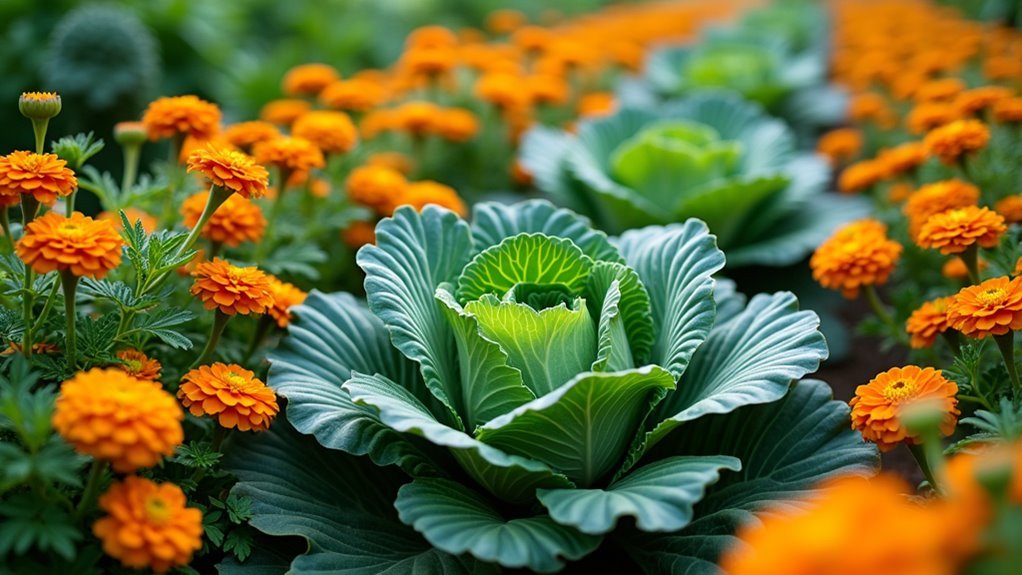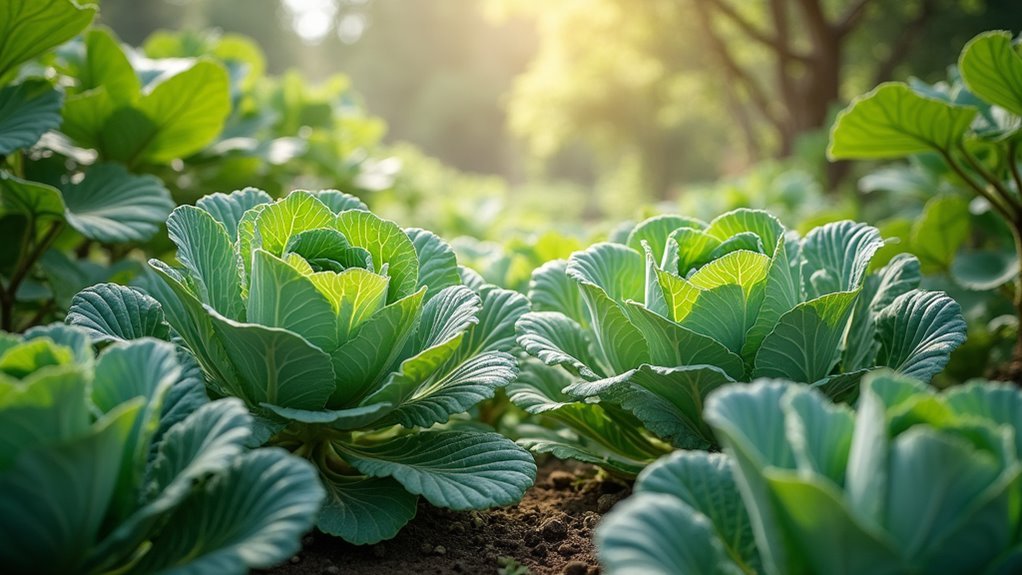You’ll effectively repel cabbage worms by planting aromatic herbs like thyme, sage, and oregano around your brassica crops. These fragrant plants mask the scents that cabbage moths use to locate target plants. Add nasturtiums and mustard as trap crops to divert pests away from your valuable cabbage, broccoli, and kale. Marigolds create additional aromatic barriers, while dill attracts beneficial predators that hunt cabbage worms. Strategic companion planting combinations will maximize your garden’s natural defense system.
Understanding Cabbage Worm Behavior and Plant Preferences

Before you can effectively repel cabbage worms, you’ll need to understand what attracts these destructive pests to your garden in the first place.
Cabbage moths specifically target plants in the brassica family, including cabbage, broccoli, and kale. These adult butterflies are drawn to plants with high chlorophyll content, making green-leaved varieties their preferred targets.
You’ll notice they lay eggs on leaf undersides, creating the next generation of hungry larvae.
Understanding these plant preferences helps you strategize your defense. Since cabbage worms thrive in warm weather and produce multiple generations per season, you can use their predictable behavior against them.
Cabbage worms follow predictable patterns, thriving in warm conditions and breeding multiple times each season, making them vulnerable to strategic garden defenses.
Consider planting an infested trap crop of green brassicas away from your main garden to repel cabbage moths from your prized vegetables.
Thyme: A Powerful Aromatic Deterrent
When you’re searching for a natural solution to cabbage worm problems, thyme stands out as one of the most effective aromatic deterrents available. This hardy perennial contains thymol, providing powerful pesticidal properties against garden pests while attracting beneficial insects to enhance biodiversity.
| Growing Requirements | Pest Control Benefits | Garden Impact |
|---|---|---|
| 6-8 hours full sun | Repels cabbage moths | Attracts pollinators |
| Well-draining soil | Masks plant aromas | Enhances biodiversity |
| USDA zones 5-9 | Contains thymol compound | Deters egg-laying |
| Hardy perennial | Natural pesticidal action | Long-term protection |
Thyme’s strong scent effectively masks the aroma of susceptible plants, making them less appealing to cabbage moths seeking egg-laying sites. You’ll find this aromatic herb thrives in sunny locations with proper drainage, offering year-round protection against cabbage worms.
Clover: Natural Ground Cover Protection

You’ll find that clover serves as both a natural pest deterrent and soil-improving ground cover in your brassica garden.
This hardy plant releases eugenol, creating an aromatic barrier that cabbage worms avoid while simultaneously fixing nitrogen to benefit your crops.
Let’s explore how you can maximize clover’s repelling properties, leverage its ground coverage advantages, and implement effective planting strategies.
Clover’s Natural Repelling Properties
Since clover releases eugenol, a potent natural compound, it creates an invisible barrier that cabbage worms instinctively avoid. This aromatic defense mechanism makes clover an excellent companion plant when you’re looking to repel cabbage worms naturally.
You’ll find that white clover works particularly well as natural ground cover around your brassicas, providing dual protection through scent deterrence and habitat creation for beneficial insects.
The eugenol emission doesn’t just ward off pests—it actively contributes to reducing overall pest populations in your garden.
When you interplant clover with cabbage family crops, you’re establishing a protective ecosystem that enhances soil health through nitrogen fixation. This powerful combination strengthens your brassicas while maintaining continuous pest deterrence, making clover an invaluable addition to any cabbage worm management strategy.
Ground Coverage Benefits
Beyond its aromatic deterrent properties, clover transforms your garden bed into a living fortress through extensive ground coverage that strengthens your cabbage’s natural defenses. This dense natural ground cover creates multiple layers of protection that effectively repel cabbage worms while enhancing your garden’s ecosystem.
Clover’s thick carpet suppresses weeds that compete for essential nutrients, ensuring your cabbage plants receive maximum resources. The nitrogen-fixing roots continuously boost soil fertility, creating healthier plants naturally resistant to pest damage.
This robust ground cover attracts beneficial insects like predator beetles that hunt cabbage worms, establishing a biological control system. Year-round coverage prevents soil erosion and maintains garden stability.
You’ll protect plants through clover’s thorough approach—deterring pests while building stronger, more resilient growing conditions for thriving cabbage crops.
Planting and Maintenance Tips
When establishing clover as your natural cabbage worm deterrent, timing and proper soil preparation determine your success.
Plant white clover seeds in early spring or fall for ideal establishment. You’ll want to scatter seeds around your cabbage plants at a rate of 2-3 pounds per 1,000 square feet. This companion planting strategy creates beneficial ground cover that deters pests while improving soil nitrogen.
For maintenance tips, mow your clover regularly to promote dense growth and prevent excessive flowering. This keeps the ground cover manageable while maintaining its pest-deterrent properties.
Clover thrives in various soil conditions and tolerates both drought and moisture, requiring minimal care. The dense mat it forms reduces weeds and provides habitat for beneficial insects that naturally control cabbage worms.
Sage: Masking Scents and Confusing Pests

You can harness sage’s powerful aromatic leaves to create a natural barrier that masks the scents cabbage moths rely on to locate their target plants.
When you plant sage near your cabbage family crops, its strong fragrance confuses these pests and disrupts their navigation system.
This scent-masking strategy effectively reduces moth attraction to your garden without requiring harsh chemical interventions.
Sage’s Scent Masking Properties
Aromatic sage releases powerful compounds that effectively mask the scents cabbage moths rely on to locate their favorite host plants. When you plant sage among your brassica family crops, you’re creating a natural shield that confuses these destructive pests.
The herb’s strong fragrance contains thymol and other compounds that interfere with moths’ ability to detect their preferred targets like cabbage, broccoli, and kale.
You’ll find sage works exceptionally well as companion plants because it doesn’t just repel cabbage moths—it actively disrupts their hunting mechanisms. The masking effect makes your vulnerable crops virtually invisible to these pests, forcing them to search elsewhere for suitable hosts.
This natural camouflage technique protects your entire garden without harmful chemicals.
Confusing Cabbage Moth Navigation
How does sage turn your garden into a maze of confusion for cabbage moths?
When you plant sage as a companion plant near your brassicas, its aromatic oils create a sensory barrier that disrupts moth navigation patterns.
These pests rely on chemical signals to locate their target plants, but sage’s strong fragrance overwhelms their ability to detect the specific scents they’re searching for.
You’ll effectively scramble their GPS system, causing them to fly past your cabbage without landing.
This natural pest management strategy doesn’t just repel individual moths—it creates widespread confusion throughout your garden space.
Oregano: Strong Fragrance Defense
When oregano releases its potent fragrance, cabbage worms instinctively avoid the area, making this Mediterranean herb one of your garden’s most reliable defenders against these destructive pests.
Oregano’s powerful scent acts as a natural shield, driving cabbage worms away from your vulnerable brassica plants with effortless efficiency.
This strong fragrance creates an invisible barrier that’ll repel cabbage worms from your precious brassica crops. As a companion plant, oregano delivers exceptional pest-repelling benefits while requiring minimal effort.
Here’s why oregano earns its place in your garden:
- Thrives in zones 4-10 – adapts to nearly any climate you’re gardening in
- Needs just one inch of water weekly – won’t burden your watering schedule
- Grows perfectly in containers – prevents unwanted spreading while maintaining effectiveness
- Doubles as culinary herb – harvest fresh oregano for your kitchen
- Extremely low maintenance – plant once and enjoy years of protection
You’ll love how this dual-purpose herb protects your vegetables while enhancing your cooking.
Hyssop: Beautiful Blooms That Repel
Beyond oregano’s proven effectiveness, hyssop offers an equally powerful yet more visually striking solution to your cabbage worm problems. This hardy perennial produces stunning blue or purple flowers while delivering robust aromatic properties that repel cabbage moths and flea beetles from your brassica crops.
| Feature | Benefit |
|---|---|
| Fragrant stems | Natural pest repellent against cabbage moths |
| Colorful blooms | Attracts beneficial pollinators to garden |
| Non-invasive growth | Won’t overtake surrounding plants |
| Pruning response | Enhanced aromatic properties when trimmed |
Growing 2 feet tall in zones 4-9, hyssop thrives in well-drained soil with full sun. Regular pruning encourages bushier growth and strengthens its pest-fighting abilities. You’ll appreciate how this beautiful herb protects your crops while adding ornamental value to your garden space.
Borage: Dual-Purpose Pest Management
While hyssop excels at repelling pests, borage takes garden protection to the next level by simultaneously deterring cabbage moths and attracting beneficial insects that’ll strengthen your entire ecosystem.
Borage’s strong scent confuses cabbage moths, creating an effective shield around your brassicas. This hardy annual thrives in full sun and well-drained soil, making integration effortless. Its deep roots improve soil health while providing natural pest management.
Borage creates a natural fortress around your brassicas while enriching soil through its powerful root system and pest-deterring aromatics.
- Watch bees and predatory wasps flock to your garden, creating a thriving beneficial insect army
- Enjoy peace of mind knowing your cabbage and kale are naturally protected from devastating worm infestations
- Harvest beautiful, cucumber-flavored edible leaves for fresh salads and elegant garnishes
- Experience the satisfaction of dual-purpose gardening that maximizes every square foot
- Celebrate improved garden health through borage’s soil-enriching deep root system
Chamomile: Gentle Scent Masking Properties
You’ll find chamomile’s gentle scent works as a natural mask that confuses cabbage moths searching for their preferred brassica targets.
When you plant this fragrant herb near your cabbage family crops, its essential oils create an aromatic barrier that makes your vegetables less detectable to egg-laying pests.
This companion planting strategy doesn’t just repel unwanted insects—it also attracts beneficial pollinators while adding beautiful daisy-like flowers to your garden space.
Chamomile’s Natural Scent Masking
Although cabbage moths rely heavily on scent to locate their preferred host plants, chamomile’s delicate fragrance creates an effective olfactory shield around your brassicas. This gentle masking technique helps repel cabbage worms by disrupting the moths’ natural detection system.
Chamomile’s scent-masking benefits include:
- Confusing cabbage moths through complex aromatic layers that hide your crops
- Attracting beneficial insects like predatory wasps that naturally control pest populations
- Creating natural barriers around vulnerable plants without harsh chemicals
- Supporting a healthier ecosystem through increased biodiversity in your garden
- Providing dual protection by both masking scents and encouraging helpful predators
When you plant chamomile near your cabbage, broccoli, and kale, you’re establishing a sophisticated defense system that works around the clock to protect your harvest.
Planting Chamomile Near Brassicas
When you’re ready to establish this natural defense system, position chamomile plants approximately 12-18 inches away from your brassicas to create an effective scent barrier without competing for nutrients.
This strategic placement allows chamomile to repel cabbage moths while attracting beneficial insects like parasitic wasps that naturally control cabbage worms.
Choose sunny locations with well-drained, sandy soil where chamomile thrives best alongside your brassica family crops.
You’ll create a balanced ecosystem that enhances soil health while protecting your cabbage and broccoli.
Regular flower harvesting maintains the plant’s effectiveness and provides you with fresh herbal tea, making this companion planting method both practical and rewarding for your garden’s pest management strategy.
Chamomile Companion Planting Benefits
Chamomile’s delicate, apple-like fragrance creates a natural masking effect that confuses cabbage moths seeking their preferred brassica hosts. This companion planting strategy effectively helps repel these destructive pests while providing multiple garden benefits beyond pest control.
When you establish chamomile near your cabbage family crops, you’ll experience:
- Enhanced crop protection – Natural deterrent against cabbage moths and their larvae
- Beneficial insect attraction – Parasitic wasps arrive to hunt cabbage worms naturally
- Improved soil biodiversity – Pollinators and helpful organisms thrive in your garden
- Better vegetable flavor – Companion planting enhances the taste of nearby brassicas
- Reduced chemical dependency – Organic pest control eliminates need for harsh pesticides
Chamomile’s gentle presence transforms your garden into a thriving ecosystem where beneficial insects patrol naturally.
Celery: Strategic Placement for Maximum Effect
Since celery produces a strong, distinctive scent that naturally deters cabbage moths, you’ll want to position these aromatic plants strategically around your brassica crops.
Place celery at the edges of garden beds to create a natural barrier that prevents pests from reaching your cabbage family plants. This strategic placement maximizes celery’s ability to repel cabbage moths before they can lay eggs on vulnerable crops.
As an excellent companion plant, celery thrives in full sun and well-drained soil alongside brassicas.
Interplanting increases biodiversity, confusing pests and providing broader protection. You’ll need to harvest celery regularly throughout the growing season to maintain its pest-repelling qualities and encourage continued growth, ensuring maximum effectiveness against cabbage worms.
Mustard as Trap Crops: Sacrificial Planting
While celery creates a protective barrier through repelling scents, mustard plants take a completely different approach by serving as sacrificial trap crops that deliberately attract cabbage moths away from your valuable brassicas.
Mustard plants act as sacrificial decoys, deliberately luring cabbage moths away from your prized brassica vegetables through strategic trap cropping.
This strategic sacrificial planting method transforms mustard into pest magnets, drawing cabbage moths to lay eggs on mustard leaves instead of your prized cabbage, broccoli, or kale.
You’ll manage pests more effectively since removing infested mustard plants eliminates entire pest populations at once.
Here’s how mustard trap crops revolutionize your garden defense:
- Fast-growing mustard outcompetes pests for your attention
- Succession planting creates continuous protection throughout growing seasons
- Easy removal eliminates infestations before they spread
- Significant reduction in cabbage worm populations
- Healthier brassica crops with minimal chemical intervention
Plant mustard strategically near your main brassica crops for maximum protective impact.
Nasturtiums: Colorful Pest Diversion
Nasturtiums offer gardeners a brilliant dual-purpose solution that combines stunning visual appeal with powerful pest protection.
These vibrant flowers function as an effective trap crop, drawing cabbage worms away from your valuable brassica plants like cabbage and broccoli. You’ll find nasturtiums incredibly easy to grow in various garden conditions, making them perfect for organic pest management strategies.
What makes nasturtiums particularly valuable is their ability to repel pests while serving multiple purposes. Their colorful blooms and foliage create an attractive decoy that diverts harmful insects from more susceptible crops.
You can also harvest both leaves and flowers since they’re completely edible, adding peppery flavor to salads and dishes. By planting nasturtiums around your brassicas, you’ll establish a resilient garden ecosystem that considerably reduces cabbage worm infestations.
Marigolds: Traditional Garden Guardians
Though nasturtiums excel as trap crops, marigolds take a different approach by creating an aromatic barrier that actively repels cabbage moths before they can lay eggs.
These traditional garden guardians contain thiophenes—natural insect repellents that make cabbage moths think twice about settling in your garden.
You’ll find marigolds incredibly effective at preventing cabbage worms while attracting beneficial insects that hunt remaining pests.
Here’s why marigolds deserve a spot in your cabbage patch:
- Powerful scent creates an invisible shield against destructive moths
- Natural compounds actively repel pests without harmful chemicals
- Bright blooms attract pest-hunting beneficial insects to your garden
- Easy maintenance thrives in full sun with minimal care required
- Extended protection continues working when you deadhead regularly
This dual-action pest control makes marigolds invaluable companions for your brassica crops.
Dill: Attracting Beneficial Predators
You’ll find dill’s feathery foliage does more than add flavor to your kitchen—it’s a magnet for parasitic wasps that hunt down cabbage worms.
These tiny warriors, along with other beneficial predators, naturally keep your brassica crops protected when you enhance their presence through strategic plantings.
Dill Attracts Parasitic Wasps
While dill’s feathery foliage adds visual appeal to your garden, its true value lies in attracting parasitic wasps that naturally control cabbage worm populations. These tiny Trichogramma species become your silent allies, laying eggs inside cabbage worms and eliminating them naturally.
You’ll love how this organic pest control method transforms your brassicas garden:
- Parasitic wasps hunt down cabbage worms with relentless precision
- Dill’s strong aroma repels destructive cabbage moths from your crops
- Beneficial insect populations multiply, creating lasting protection
- Chemical interventions become unnecessary as nature takes control
- Enhanced biodiversity strengthens your entire garden ecosystem
Plant dill in full sun with well-draining soil alongside your brassicas. Regular plantings increase parasitic wasp populations, giving you powerful, sustainable pest control that works around the clock.
Natural Predator Enhancement
Beyond parasitic wasps, dill acts as a magnet for other powerful predators that’ll revolutionize your cabbage protection strategy.
When you plant this versatile companion plant near your cabbage crops, you’ll attract ladybugs and lacewings—voracious hunters that consume hundreds of cabbage worms throughout their lifecycle.
These beneficial insects establish permanent residence around dill’s umbrella-shaped flowers, creating a natural pest control army that works 24/7.
You’ll maximize predator populations by harvesting dill regularly, encouraging continuous blooming that provides nectar and pollen.
This strategic approach transforms your garden into a balanced ecosystem where natural predators outnumber pests.
Since dill thrives in full sun and well-drained soil, you can easily integrate it anywhere cabbage family crops grow, ensuring thorough protection.
Planting Dill Strategically
Strategic placement of dill around your cabbage patch creates multiple layers of protection that enhance its pest-fighting potential. This aromatic companion plant works through multiple mechanisms to defend your brassicas from cabbage worms and cabbage moths.
Position dill plants strategically to maximize their protective benefits:
- Scatter throughout the garden – Don’t cluster dill in one area; spread it around cabbage rows for broader coverage.
- Plant upwind – Position dill where prevailing winds carry its strong scent across vulnerable crops.
- Create border barriers – Establish dill perimeters around cabbage beds to confuse approaching pests.
- Interplant directly – Place dill between cabbage plants for intimate protection and beneficial insects attraction.
- Maintain continuous succession – Stagger plantings every two weeks to guarantee constant aromatic coverage throughout the growing season.
Creating Effective Plant Combinations and Layout Strategies
When you thoughtfully arrange companion plants around your brassicas, you’ll create a natural defense system that confuses and deters cabbage moths before they can establish themselves in your garden.
Plant repellent species like thyme, sage, and oregano directly around your cabbage family crops to mask their scent. Use trap crops such as mustard strategically placed at garden borders to lure moths away from valuable plants.
Strategic placement of aromatic herbs like thyme and sage creates a natural scent barrier that effectively masks brassicas from detecting cabbage moths.
Incorporate diverse plant colors by choosing red and purple cabbage varieties, which moths find less attractive than green options. Create a protective barrier with clover and borage that attracts beneficial insects to prey on harmful pests.
Don’t forget to rotate plant locations each season, disrupting cabbage worm life cycles and maintaining your garden’s natural defenses.
Frequently Asked Questions
What Plants Repel Cabbage Worms?
You can repel cabbage worms by planting thyme, sage, oregano, white clover, and hyssop around your garden. These aromatic herbs emit strong scents that deter cabbage worms while thriving in sunny conditions.
Does Mint Repel Cabbage Worms?
Yes, you’ll find mint effectively repels cabbage worms by deterring cabbage moths from laying eggs. The plant’s strong essential oils confuse and repel these pests, making it an excellent natural companion plant for your brassica crops.
How to Keep Cabbage Looper Away From Plants?
You can keep cabbage loopers away by planting thyme and sage nearby, using row covers as barriers, regularly inspecting leaf undersides for eggs, and growing clover to attract beneficial predator beetles.
What Is the Best Insect Repellent for Cabbage?
You’ll find thyme works best as an insect repellent for cabbage since its thymol compound effectively deters pests. Plant it in well-draining soil with full sun exposure for ideal protection.
In Summary
You’ll find success by combining these companion plants strategically around your cabbage crops. Don’t rely on just one variety—mix aromatic herbs like thyme and oregano with colorful nasturtiums and marigolds for maximum protection. You’re creating a natural defense system that confuses pests while attracting beneficial insects. Start planting these companions early in the season, and you’ll notice fewer cabbage worms damaging your harvest throughout the growing period.





Leave a Reply